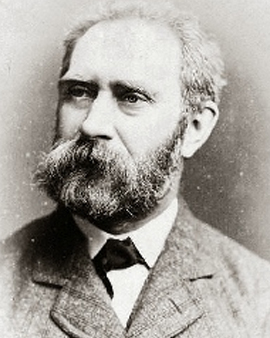The Englishman Edwin Long was an extremely successful genre, history, Bible and portrait painter of the 19th century. He grew up in Bath, a city in the southwest of England known for its natural thermal springs. At the age of 20, Edwin Long left his beloved family home to study painting at the prestigious London Leigh's Academy, a private art school. During his studies, he applied to the Royal Academy of Arts twice without success. The school was already one of the country's most important art institutions at the time and trained talented young artists in the fields of painting, sculpture and architecture.
After his studies, the artist travelled to Italy before returning to his home town of Bath in 1848 to earn a living as a portrait painter. Edwin Long lived in Bath for ten years before moving to London again. Here he met John Phillip. The Scottish painter had a great passion for Spanish culture and was therefore known under the nickname "Spanish Phillip". Together the painters travelled to Spain. Long discovered his talent for genre painting. Paintings by Spanish painters like Diego Velázquez inspired him a lot. So it came about that Edwin was also gripped by the enthusiasm for the country. He returned to Spain again and again. Later, trips to Syria and Egypt followed. Especially his oriental scenes were very popular among the population of London. In 1875, at the age of 46, his long-awaited breakthrough finally came. He was allowed to show his paintings at an exhibition at the Royal Academy of Arts. Already one year later, he became a member of the Royal Academy of Arts. This was certainly a satisfaction for him, after his failed applications at a young age.
Now he taught young students in the subjects art and painting. One of his most famous students was George Clausen, who was knighted by the Queen in 1927; a great distinction for a citizen of Great Britain. Besides his work as a lecturer, Long also opened his own gallery in London. Here he exhibited his works and made portraits of famous personalities from the Upper Class, such as Cardinal Henry Edward Manning. The artist had many of his works reproduced as engravings.
×





.jpg)
.jpg)
.jpg)
.jpg)
.jpg)
.jpg)
.jpg)
.jpg)
.jpg)
.jpg)
.jpg)
.jpg)
.jpg)
.jpg)
.jpg)
.jpg)
.jpg)
.jpg)
.jpg)
.jpg)
.jpg)
.jpg)
.jpg)
.jpg)
_-_(MeisterDrucke-1315636).jpg)
_-_(MeisterDrucke-1315636).jpg)
.jpg)
.jpg)
.jpg)
.jpg)
.jpg)
.jpg)
.jpg)
.jpg)
.jpg)
.jpg)
.jpg)
.jpg)
.jpg)
.jpg)
.jpg)
.jpg)
_-_(MeisterDrucke-122901).jpg)
_-_(MeisterDrucke-122901).jpg)
.jpg)
.jpg)
.jpg)
.jpg)
.jpg)
.jpg)
.jpg)
.jpg)
.jpg)
.jpg)
.jpg)
.jpg)
.jpg)
.jpg)
.jpg)
.jpg)
_-_(MeisterDrucke-136709).jpg)
_-_(MeisterDrucke-136709).jpg)
_-_(MeisterDrucke-1131179).jpg)
_-_(MeisterDrucke-1131179).jpg)
.jpg)
.jpg)
.jpg)
.jpg)
.jpg)
.jpg)
.jpg)
.jpg)
.jpg)
.jpg)
.jpg)
.jpg)
.jpg)
.jpg)






